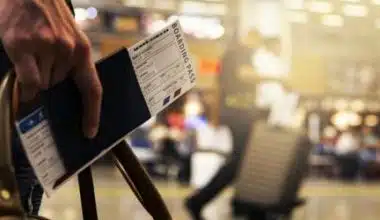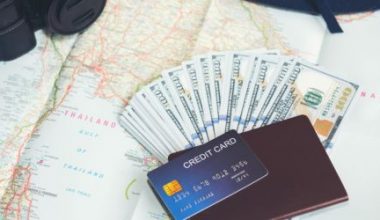Deodorants can be taken on a plane, but there are restrictions. Stick deodorants are allowed, while spray, gel, liquid, cream, pastes, and roll-on deodorants must be in 3.4-ounce containers. Aerosol deodorants must fit into a single quart-sized baggie. Checked baggage can be used if larger containers exceed the 3.4-ounce limit. International travel regulations may vary, and medical exceptions may require documentation. Additional security screening may also be required. It is important to pay attention to the do’s and don’ts during air travel, as they provide you with key information. We have compiled a list of things to know with respect to taking deodorant on a plane.
Can You Take Deodorant On A Plane?
It is possible to take deodorant on a plane, but there are some restrictions to keep in mind.
Rules For Taking Deodorant On A Plane
#1. Stick Deodorant
Stick deodorant is generally allowed in any size and does not need to be placed in a quart-sized baggie. Powders and crystals are also allowed.
#2. Spray, Gel, Liquid, Cream, Pastes, and Roll-On Deodorants
These types of deodorants need to be in containers no larger than 3.4 ounces (100 ml) and placed in a clear quart-sized baggie. This applies to both carry-on and checked baggage. If you have a larger container, you can consider placing it in your checked baggage.
#3.Aerosol Deodorants
Aerosol deodorants, such as spray cans, are also subject to the 3-1-1 rule. Each can must be 3.4 ounces (100 ml) or less and all cans must fit into a single quart-sized baggie. Keep in mind that there are additional restrictions on aerosol products due to their potential to explode or cause harm. Some airlines may have specific rules or restrictions on bringing aerosol products onboard, so it’s always a good idea to check with your airline before your flight.
#4. Checked Baggage
If you have deodorant in larger containers that exceed the 3.4-ounce limit, you have the option of packing them in your checked baggage. There are generally no size restrictions for deodorant in checked baggage, but it’s a good idea to ensure that the container is sealed properly to prevent leakage during the flight.
#5. International Travel
If you are traveling internationally, it’s important to note that rules may vary depending on the country you are departing from or arriving in. It’s advisable to check the specific regulations of the countries involved to ensure compliance.
#6. Medical Exceptions
If you require a specific type of deodorant for medical reasons, such as a prescription or medically necessary gel or cream, you may be allowed to bring it in larger quantities. However, it’s essential to carry documentation from a medical professional to support your need for the item.
#7. Additional Security Screening
In some cases, security personnel may require additional screening of your deodorant or other personal care items. This can include visual inspection, swabbing for explosives, or other security measures. Cooperate with security personnel and follow their instructions to facilitate the process.
#8. Separate Bag
When packing your deodorant in a clear quart-sized baggie, make sure it is easily accessible and separate from other liquids, gels, or aerosols. This allows for quick inspection during the security screening process.
#9. Solid Gel or Cream Deodorants
Some gel or cream deodorants may solidify and become firm or semi-solid at lower temperatures, especially in colder airplane cabins. Keep this in mind when choosing the consistency of your deodorant to avoid any inconvenience during your flight.
#10. Consider Travel-Sized Options
To comply with the liquid restrictions, consider purchasing travel-sized deodorants or transferring your preferred deodorant into smaller containers. This ensures that you can carry them in your carry-on bag without any issues.
Reasons Why You Can’t Take Deodorant On A Plane
There are several reasons why you may not be able to take deodorant on a plane. These reasons include:
#1. Liquid Restrictions
If your deodorant is in liquid form, such as a spray, gel, roll-on, or cream, it must adhere to the liquid restrictions imposed by the Transportation Security Administration (TSA). These restrictions state that liquids must be in containers of 3.4 ounces (100 milliliters) or less and placed in a clear quart-sized baggie. Larger containers of liquid deodorant should be placed in checked baggage.
#2. Security Concerns
Certain types of deodorants, such as aerosol deodorants, may be restricted due to security concerns. Aerosols are pressurized containers that can potentially pose a risk if mishandled or accidentally discharged. Therefore, they may not be allowed in carry-on baggage. deodorants.
#3. Powder-like Substances
In some cases, powders or powder-like substances may be subject to additional screening or restrictions. While solid deodorants are generally allowed in carry-on bags, powders greater than 12 ounces (350 milliliters) may require separate screening or additional scrutiny. It’s recommended to place non-essential powders greater than 12 ounces in checked bags for convenience.
#4. International Regulations
When traveling internationally, it’s important to be aware that different countries may have regulations regarding deodorant and other personal care items. It’s advisable to check the specific regulations of the countries you are departing from and arriving in to ensure compliance.
#5. Quantity Restrictions
The Federal Aviation Administration (FAA) imposes restrictions on the total amount of restricted medicinal and toiletry articles, including deodorants, in checked baggage. The total aggregate quantity per person cannot exceed 2 kg (70 ounces) or 2 L (68 fluid ounces). The capacity of each container must not exceed 0.5 kg (18 ounces) or 500 ml (17 fluid ounces).
#6. Aerosol Deodorants
Aerosol deodorants may be subject to restrictions due to their pressurized containers. The FAA requires that permitted aerosol release devices (button or nozzle) be protected by caps or other suitable means to prevent accidental release It’s advisable to check with the TSA or your airline for specific guidelines regarding aerosol deodorants.
#7. Powder Restrictions
While solid deodorants are generally allowed in carry-on bags, powders or powder-like substances may be subject to additional screening or restrictions. Powders greater than 12 ounces (350 milliliters) may require separate screening or additional scrutiny. It’s recommended to place non-essential powders greater than 12 ounces in checked bags for convenience.
#8. International Regulations
Different countries may have their own regulations regarding deodorant and other personal care items. It’s best to check the specific regulations of the countries you are departing from and arriving in to ensure compliance.
Alternative Deodorant That You Can Take On A Plane
When it comes to alternative options for taking deodorant on a plane, here are a few possibilities:
#1. Baking Soda
Baking soda, also known as sodium bicarbonate, is a natural alternative that can be used as a deodorant. It is known for its ability to absorb odors and has been used for various purposes, including odor prevention and cleaning. Some people mix baking soda with a few drops of essential oil and apply it to their underarms as a natural deodorant. Baking soda may not be suitable for everyone, and some may experience skin irritation or reactions. It’s recommended to test it on a small area of skin before using it as a deodorant.
#2. Solid Deodorant
Solid deodorant, such as stick deodorant or deodorant bars, is a convenient option for travel. They are generally allowed in both carry-on and checked baggage without any size restrictions. They are easy to pack and do not require a quart-sized baggie for carry-on travel. Solid deodorants come in various forms, including natural and plastic-free options, making them a practical choice for those concerned about sustainability.
#3. Deodorant Wipes
Another alternative to traditional deodorant is using deodorant wipes. These wipes are pre-moistened with deodorant and can be used to freshen up on the go. Deodorant wipes are compact, portable, and often come in travel-friendly packaging. They can be a convenient option for short trips or when access to traditional deodorant is limited. However, it’s important to note that deodorant wipes may not provide the same long-lasting odor protection as regular deodorant.
#4. Crystal Deodorants
Crystal deodorants are made from mineral salts, such as potassium alum or ammonium alum. They come in the form of a solid crystal or stone and are typically applied to damp skin. These work by creating a thin layer of mineral salts on the skin that helps prevent odor-causing bacteria from forming. Crystal deodorants are generally allowed in both carry-on and checked baggage without any size restrictions.
#5. Powder Deodorants
Powder deodorants, also known as body powders, are another alternative option. These deodorants are made from ingredients like baking soda, cornstarch, or arrowroot powder. Powder deodorants work by absorbing moisture and neutralizing odors. They are often available in travel-friendly sizes and are allowed in both carry-on and checked baggage.
#6. Homemade/Natural Deodorants:
Many people choose to make their deodorants using natural ingredients. Homemade deodorants often include ingredients like coconut oil, shea butter, essential oils, and baking soda. If you choose to bring your homemade deodorant on a plane, it’s important to ensure it complies with the TSA’s 3-1-1 rule for liquids and gels in carry-on baggage.
#7. Travel-Sized Deodorants
If you prefer to stick with traditional deodorants, many brands offer travel-sized versions that are within the allowed limits for carry-on liquids. These smaller-sized deodorants are usually available in both solid stick and liquid/gel forms. They can be easily packed in your quart-sized baggie and are a convenient option for short trips or when you prefer to travel light.
Effects On The Rules For Taking Deodorant On A Plane
The rule for taking deodorant on a plane, specifically the TSA’s 3-1-1 rule, has several impacts. Here are the effects:
#1. Size Limitations
The 3-1-1 rule restricts the size of liquid, gel, cream, and spray deodorants that can be carried in carry-on baggage. Each container must be 3.4 ounces (100 ml) or less, and all containers must fit into a single quart-sized clear plastic bag. This rule helps ensure that liquids and gels are easily screened and reduces the risk of potential security threats.
#2. Convenience and Accessibility
The rule allows passengers to bring travel-sized deodorants in their carry-on bags, making it convenient for freshening up during flights or layovers. Travel-sized deodorants are often available for purchase and are designed to comply with the 3-1-1 rule. This ensures that passengers have access to personal hygiene products while traveling without the need to check a bag or rely on airport amenities.
#3. Security Measures
The 3-1-1 rule is part of the security measures implemented by the TSA to ensure the safety of air travel. Limiting the size of liquids and gels helps in the efficient screening of carry-on baggage, reducing the risk of potential threats. It allows security personnel to quickly identify and inspect these items, maintaining the safety and security of passengers and aircraft.
#4. Checked Baggage Considerations
If a deodorant container exceeds the 3.4-ounce limit, passengers have the option to pack it in their checked baggage. This ensures that larger-sized deodorants can still be transported, albeit in checked luggage. It’s important to ensure that the container is properly sealed to prevent leakage during the flight.
#5. Awareness and Compliance
The rule for deodorant and other liquids and gels has raised awareness among passengers about the restrictions and requirements for carrying such items on a plane. Passengers are encouraged to familiarize themselves with the 3-1-1 rule and other guidelines to ensure a smooth and hassle-free security screening process.
#6. Consistency and Standardization
The rule for taking deodorant on a plane, along with other liquid and gel restrictions, helps maintain consistency and standardization in airport security procedures. By implementing a uniform rule, it ensures that all passengers are subject to the same guidelines, regardless of their destination or airline.
#7. Mitigating Potential Threats
The 3-1-1 rule plays a role in mitigating potential threats related to liquids and gels. By limiting the size of containers, it reduces the possibility of individuals carrying hazardous substances on board. This helps enhance the overall safety of air travel by minimizing the risk of explosives, flammable substances, or other harmful materials being brought onto an aircraft.
#8. Efficient Screening Process
The size limitations for deodorant and other similar items contribute to the efficiency of the security screening process. When passengers comply with the rules, it allows security personnel to quickly screen and identify potentially prohibited items. This helps expedite the process by reducing wait times and ensuring a smoother experience for travelers.
#9. Focus on Core Security Concerns
By implementing size restrictions for deodorant and other liquids and gels, security personnel can focus their attention on more significant security concerns. The rule helps prioritize the screening of items that pose a higher risk, such as weapons or explosives, rather than spending excessive time inspecting larger quantities of liquids or gels that might be carried on board.
#10. International Consistency
The rule for deodorant and other liquid and gel restrictions aligns with international aviation security standards. Many countries have similar regulations in place to ensure harmonization and consistency in security measures across borders. This facilitates international travel and promotes a global approach to aviation security.
Why Can’t You Bring Deodorant On A Plane?
The rule for taking deodorant on a plane is in place to ensure the safety and security of air travel. It limits the size of liquid, gel, cream, and spray deodorants to prevent potential security threats. The rule promotes consistency in airport security procedures, streamlines the screening process, and encourages awareness and compliance among passengers. Travel-sized and solid stick deodorants are generally allowed, allowing passengers to maintain personal hygiene during their journey. By following the guidelines, passengers contribute to a secure and efficient travel experience.
Can I Take Deodorant On A Plane In Checked Luggage?
Yes, you can bring deodorant in checked luggage. The Federal Aviation Administration (FAA) allows restricted medicinal and toiletry articles, including aerosol deodorants, in checked baggage. The total aggregate quantity per person should not exceed 2 kg (70 ounces) or 2 L (68 fluid ounces), and the capacity of each container must not exceed 0.5 kg (18 ounces) or 500 ml (17 fluid ounces). To prevent accidental release, aerosol-release devices must have caps or other suitable safeguards.
Can I Bring Lotion On A Plane?
You are allowed to bring lotion on a plane in your carry-on baggage, but there are restrictions to keep in mind. The lotion must be in a travel-sized container of 3.4 ounces (100 milliliters) or less, and all liquids must fit into a quart-sized clear plastic bag. Each passenger is limited to one quart-sized bag of liquids. If you have larger containers of lotion, you can pack them in your checked baggage. Duty-free liquids purchased internationally and packed in a secure, tamper-evident bag are allowed in carry-on bags on inbound international flights.
What Is Not Allowed On Airplanes?
Certain items are not allowed on airplanes, including firearms, explosives, sharp objects, sporting goods, liquids and gels, and hazardous materials. These items are generally prohibited in carry-on baggage but may be allowed in checked baggage. Sharp objects, sporting goods, and liquids must fit into a quart-sized clear plastic bag. Hazardous materials, including corrosive substances, radioactive materials, and toxic chemicals, are also not allowed.
Can I Carry Deodorant On International Flights?
Yes, you can carry deodorant on international flights. The Transportation Security Administration (TSA) allows deodorant in both carry-on and checked luggage, as long as it complies with their liquid rules. Stick deodorant is generally fine in any size, while spray, gel, liquid, cream, paste, and roll-on deodorants need to be in containers no larger than 3.4 ounces (100 milliliters) and placed in a clear quart-sized baggie in carry-on baggage. Alternatively, you can also pack deodorant in your checked baggage.
Can I Bring Toothpaste On A Plane?
You can bring toothpaste on a plane. Toothpaste that complies with liquid regulations is allowed in both checked and carry-on luggage, according to the Transportation Security Administration (TSA). Stick toothpaste is usually OK for carry-on luggage, but it must be in a travel-size container that weighs 3.4 ounces or less and be sealed in a clear plastic baggie. There is no hard cap on toothpaste quantity while checking baggage; however, it is important to be aware of airline weight and dimension limitations.
Conclusion
Baking soda, a natural deodorant, is a popular choice for travelers. Solid deodorants, such as stick or bar deodorants, are convenient for travel and eco-friendly. Deodorant wipes are compact and portable, but they may not provide long-lasting odor protection. This rule also provides convenience by allowing passengers to bring travel-size deodorants in their carry-on bags. It also ensures security measures, as larger containers can be packed in checked baggage. The rule raises awareness, maintains consistency, and mitigates potential threats by minimizing the risk of hazardous substances.
- AMERICAN AIRLINES CARRY-ON RESTRICTIONS
- CAN YOU BRING FOOD ON AN AIRPLANE? All You Need To Know
- CAN YOU TAKE MAKEUP ON A PLANE?
- WHAT IS KNOWN TRAVELER NUMBER KTN? All You Need To Know
- HOW EARLY TO ARRIVE AT THE AIRPORT






